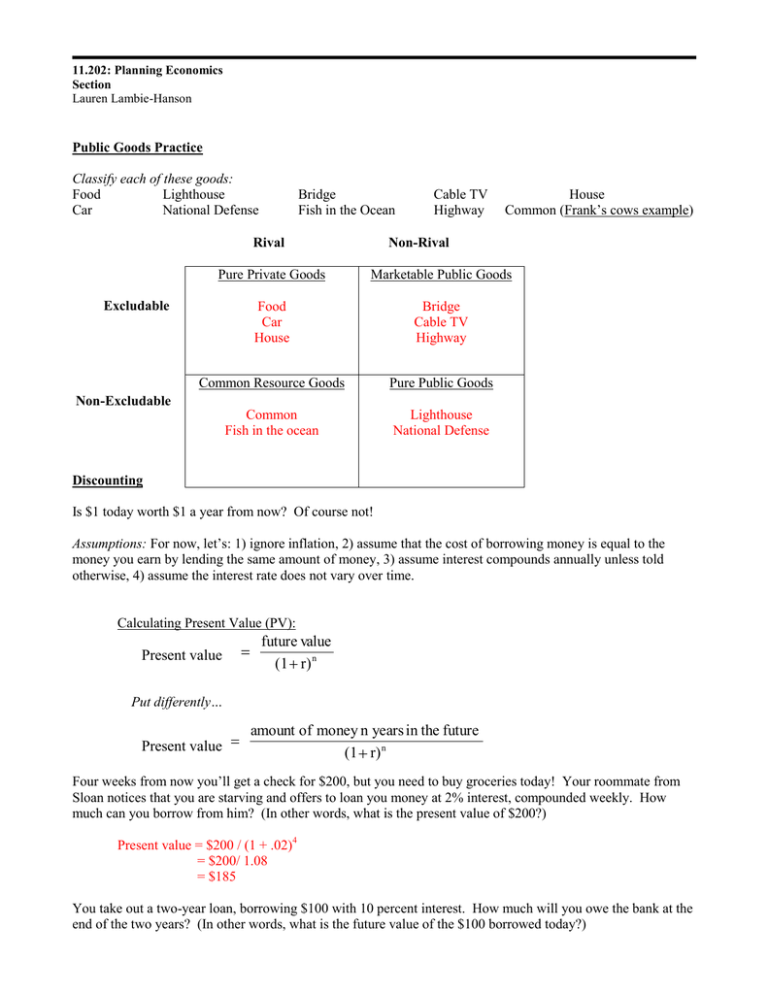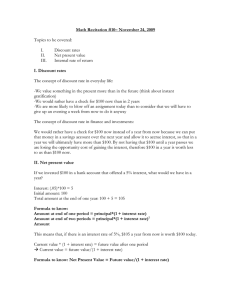Document 13651494
advertisement

11.202: Planning Economics Section Lauren Lambie-Hanson Public Goods Practice Classify each of these goods: Food Lighthouse Car National Defense Bridge Fish in the Ocean Rival Cable TV Highway House Common (Frank’s cows example) Non-Rival Pure Private Goods Marketable Public Goods Food Car House Bridge Cable TV Highway Common Resource Goods Pure Public Goods Common Fish in the ocean Lighthouse National Defense Excludable Non-Excludable Discounting Is $1 today worth $1 a year from now? Of course not! Assumptions: For now, let’s: 1) ignore inflation, 2) assume that the cost of borrowing money is equal to the money you earn by lending the same amount of money, 3) assume interest compounds annually unless told otherwise, 4) assume the interest rate does not vary over time. Calculating Present Value (PV): Present value future value (1 r) n Put differently… Present value amount of money n years in the future (1 r) n Four weeks from now you’ll get a check for $200, but you need to buy groceries today! Your roommate from Sloan notices that you are starving and offers to loan you money at 2% interest, compounded weekly. How much can you borrow from him? (In other words, what is the present value of $200?) Present value = $200 / (1 + .02)4 = $200/ 1.08 = $185 You take out a two-year loan, borrowing $100 with 10 percent interest. How much will you owe the bank at the end of the two years? (In other words, what is the future value of the $100 borrowed today?) future value = present value * (1+r)n = $100 * (1+0.1)2 = $100 * (1.1)2 = $100 * 1.21 = $121 Calculating Net Present Value (NPV): From BusinessDictionary.com: NPV is the difference between the present value (PV) of the future cash flows from an investment and the amount of the investment. Present value of the expected cash flows is computed by discounting them at the required rate of return (also called minimum rate of return). For example, an investment of $1,000 today at 10 percent will yield $1,100 at the end of the year; therefore, the present value of $1,100 at the desired rate of return (10 percent) is $1,000. The amount of investment ($1,000 in this example) is deducted from this figure to arrive at NPV which here is zero ($1,000-$1,000). A zero NPV means the project repays original investment plus the required rate of return. A positive NPV means a better return, and a negative NPV means a worse return, than the return from zero NPV. For our purposes, you can assume that the “required rate of return” is the return you’d get if you invested the principal at the market interest rate. Frank’s Example from Class: Interest rate = 8% Option A B C 2009 -20 -20 -20 2010 10 0 0 2011 10 0 0 2012 10 40 25.19 NPV 5.77 11.75 0 First, fill in option C: You deposit $20 at 8% until 2012, at which time you withdraw your entire investment. Next, calculate the NPV of each option: A: -20/(1.08)0 + 10/(1.08)1 + 10/(1.08)2 + 10/(1.08)3 = $5.77 B: -20/(1.08)0 + 40/(1.08)3 = $11.75 C: -20/(1.08)0 + [20*(1.08)3]/(1.08)3 = -20/(1.08)0 + 25.19/(1.08)3 = $0 If you could borrow as much money as you want at an interest rate of 8%, which option(s) would you choose? If you could only choose one, which would you choose? Options A and B are more profitable than simply investing $20 at the market interest rate, so they are worth borrowing to undertake. Option C would just break even if you borrowed… it would be borrowing $20 to invest $20, both at the same interest rate… that wouldn’t make much sense! Option B is the most profitable, so if you only had $20 (or could only borrow $20) to invest, option B would be the most attractive. Calculating Internal Rate of Return (IRR): 2 From BusinessDictionary.com: IRR is the average annual return earned through the life of an investment and is computed in several ways. Depending on the method used, it can either be the effective rate of interest on a deposit or loan, or the discount rate that reduces to zero the net present value of a stream of income inflows and outflows. If the IRR is higher than the desired rate of return on investment, then the project is a desirable one. By setting the NPV equal to zero, we can find the interest rate that a given investment option is effectively paying out. Consider option A, above: a $20 investment in year 0 that yields $10 payments in years 1, 2, and 3. - 20 10 10 10 NPV 0 1 2 (1 x) (1 x) (1 x) (1 x) 3 We could set NPV equal to zero and solved for x, which is option A’s internal rate of return, or the “true interest rate”. We won’t calculate this by hand, but instead we’ll use Excel. 3 MIT OpenCourseWare http://ocw.mit.edu 11.202 Planning Economics Fall 2010 For information about citing these materials or our Terms of Use, visit: http://ocw.mit.edu/terms.






